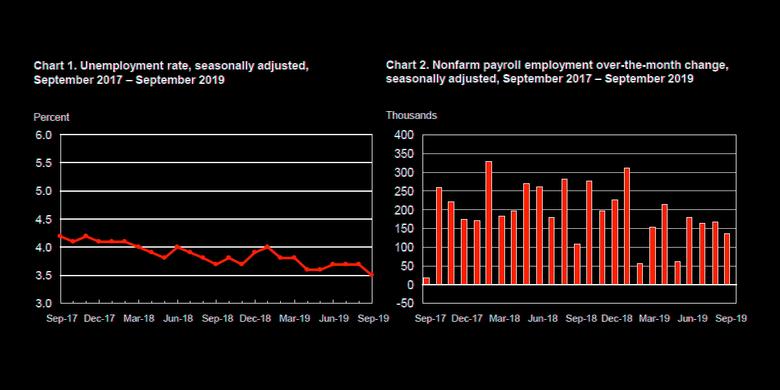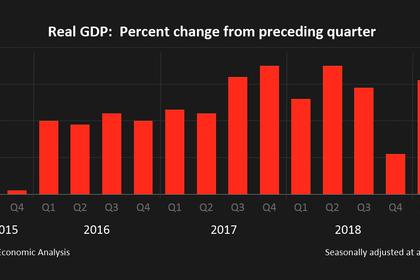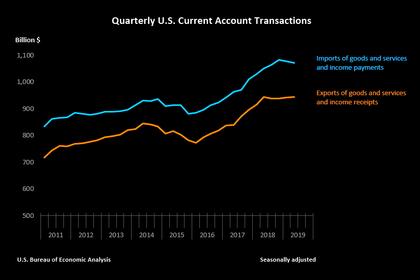
U.S. SEPTEMBER UNEMPLOYMENT RATE DOWN TO 3.5%

U.S. BLS - THE EMPLOYMENT SITUATION -- SEPTEMBER 2019
The unemployment rate declined to 3.5 percent in September, and total nonfarm payroll employment rose by 136,000, the U.S. Bureau of Labor Statistics reported today. Employment in health care and in professional and business services continued to trend up.
This news release presents statistics from two monthly surveys. The household survey measures labor force status, including unemployment, by demographic characteristics. The establishment survey measures nonfarm employment, hours, and earnings by industry. For more information about the concepts and statistical methodology used in these two surveys, see the Technical Note.
Household Survey Data
In September, the unemployment rate declined by 0.2 percentage point to 3.5 percent. The last time the rate was this low was in December 1969, when it also was 3.5 percent. Over the month, the number of unemployed persons decreased by 275,000 to 5.8 million. (See table A-1.)
Among the major worker groups, the unemployment rate for Whites declined to 3.2 percent in September. The jobless rates for adult men (3.2 percent), adult women (3.1 percent), teenagers (12.5 percent), Blacks (5.5 percent), Asians (2.5 percent), and Hispanics (3.9 percent) showed little or no change over the month. (See tables A-1, A-2, and A-3.)
Among the unemployed, the number of job losers and persons who completed temporary jobs declined by 304,000 to 2.6 million in September, while the number of new entrants increased by 103,000 to 677,000. New entrants are unemployed persons who never previously worked. (See table A-11.)
In September, the number of persons unemployed for less than 5 weeks fell by 339,000 to 1.9 million. The number of long-term unemployed (those jobless for 27 weeks or more) was little changed at 1.3 million and accounted for 22.7 percent of the unemployed. (See table A-12.)
The labor force participation rate held at 63.2 percent in September. The employment- population ratio, at 61.0 percent, was little changed over the month but was up by 0.6 percentage point over the year. (See table A-1.)
The number of persons employed part time for economic reasons (sometimes referred to as involuntary part-time workers) was essentially unchanged at 4.4 million in September.
These individuals, who would have preferred full-time employment, were working part time because their hours had been reduced or they were unable to find full-time jobs. (See table A-8.)
In September, 1.3 million persons were marginally attached to the labor force, down by 278,000 from a year earlier. (Data are not seasonally adjusted.) These individuals were not in the labor force, wanted and were available for work, and had looked for a job sometime in the prior 12 months. They were not counted as unemployed because they had not searched for work in the 4 weeks preceding the survey. (See table A-16.)
Among the marginally attached, there were 321,000 discouraged workers in September, little changed from a year earlier. (Data are not seasonally adjusted.) Discouraged workers are persons not currently looking for work because they believe no jobs are available for them. The remaining 978,000 persons marginally attached to the labor force in September had not searched for work for reasons such as school attendance or family responsibilities. (See table A-16.)
Establishment Survey Data
Total nonfarm payroll employment increased by 136,000 in September. Job growth has averaged 161,000 per month thus far in 2019, compared with an average monthly gain of 223,000 in 2018. In September, employment continued to trend up in health care and in professional and business services. (See table B-1.)
In September, health care added 39,000 jobs, in line with its average monthly gain over the prior 12 months. Ambulatory health care services (+29,000) and hospitals (+8,000) added jobs over the month.
Employment in professional and business services continued to trend up in September (+34,000). The industry has added an average of 35,000 jobs per month thus far in 2019, compared with 47,000 jobs per month in 2018.
Employment in government continued on an upward trend in September (+22,000). Federal hiring for the 2020 Census was negligible (+1,000). Government has added 147,000 jobs over the past 12 months, largely in local government.
Employment in transportation and warehousing edged up in September (+16,000). Within the industry, job growth occurred in transit and ground passenger transportation (+11,000) and in couriers and messengers (+4,000).
Retail trade employment changed little in September (-11,000). Within the industry, clothing and clothing accessories stores lost 14,000 jobs, while food and beverage stores added 9,000 jobs. Since reaching a peak in January 2017, retail trade has lost 197,000 jobs.
Employment in other major industries, including mining, construction, manufacturing, wholesale trade, information, financial activities, and leisure and hospitality, showed little change over the month.
In September, average hourly earnings for all employees on private nonfarm payrolls, at $28.09, were little changed (-1 cent), after rising by 11 cents in August. Over the past 12 months, average hourly earnings have increased by 2.9 percent. In September, average hourly earnings of private-sector production and nonsupervisory employees rose by 4 cents to $23.65. (See tables B-3 and B-8.)
The average workweek for all employees on private nonfarm payrolls was unchanged at 34.4 hours in September. In manufacturing, the average workweek and overtime remained at 40.5 hours and 3.2 hours, respectively. The average workweek of private-sector production and nonsupervisory employees held at 33.6 hours. (See tables B-2 and B-7.)
The change in total nonfarm payroll employment for July was revised up by 7,000 from +159,000 to +166,000, and the change for August was revised up by 38,000 from +130,000 to +168,000. With these revisions, employment gains in July and August combined were 45,000 more than previously reported. (Monthly revisions result from additional reports received from businesses and government agencies since the last published estimates and from the recalculation of seasonal factors.) After revisions, job gains have averaged 157,000 per month over the last 3 months.
-----
Earlier:

2019, June, 11, 09:30:00
U.S. UNEMPLOYMENT 3.6%
Total nonfarm payroll employment edged up in May (+75,000), and the unemployment rate remained at 3.6 percent, the U.S. Bureau of Labor Statistics reported.
|

2019, May, 6, 11:35:00
U.S. UNEMPLOYMENT DOWN TO 3.6%
Total nonfarm payroll employment increased by 263,000 in April, and the unemployment rate declined to 3.6 percent, the U.S. Bureau of Labor Statistics reported
|

2019, April, 8, 11:05:00
U.S. UNEMPLOYMENT 3.8%
U.S. Total nonfarm payroll employment increased by 196,000 in March, and the unemployment rate was unchanged at 3.8 percent, the U.S. Bureau of Labor Statistics reported today. Notable job gains occurred in health care and in professional and technical services.
|

2019, March, 11, 11:05:00
U.S. UNEMPLOYMENT DOWN TO 3.8%
U.S. BLS - Total nonfarm payroll employment changed little in February (+20,000), and the unemployment rate declined to 3.8 percent, the U.S. Bureau of Labor Statistics reported. Employment in professional and business services, health care, and wholesale trade continued to trend up, while construction employment decreased.
|
Earlier:







